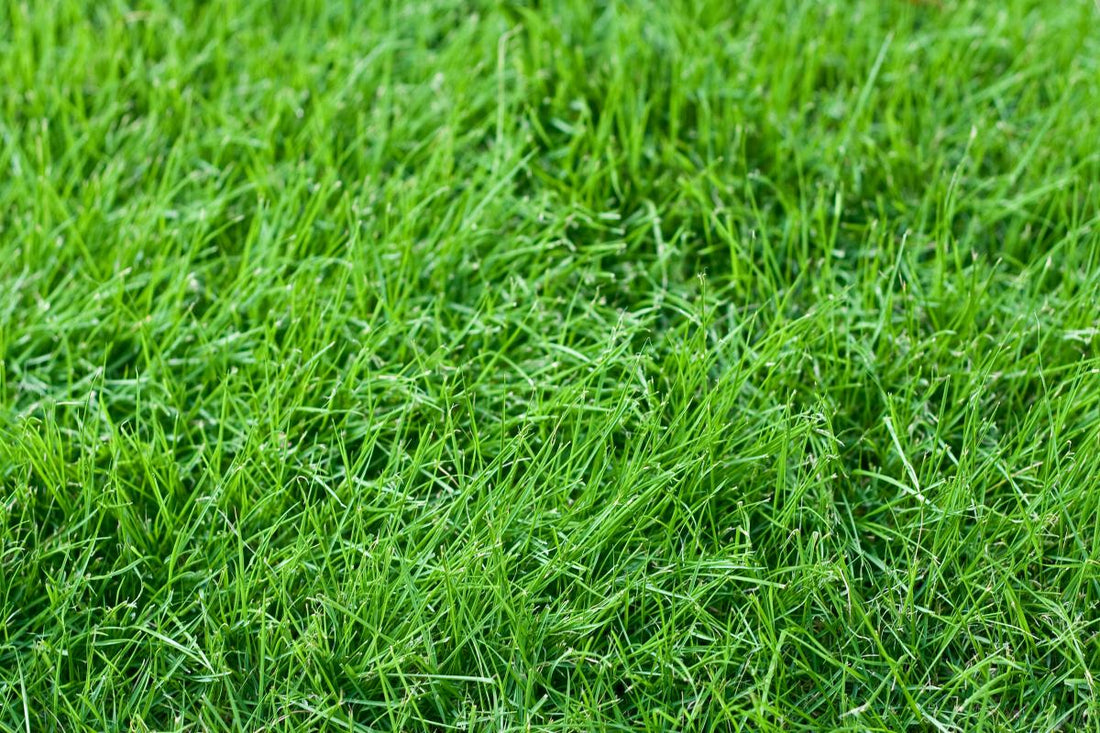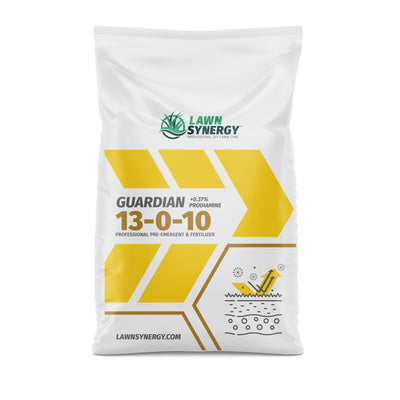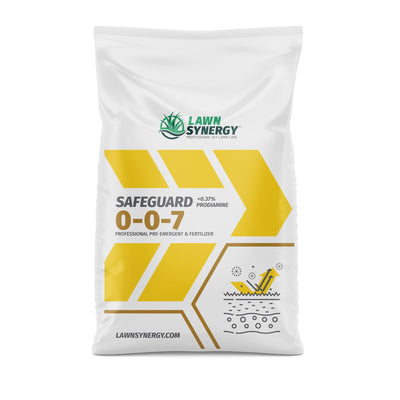If you've ever battled crabgrass, dandelions, or sandburs in your yard, you know how frustrating it can be. Preventing weeds before they grow is so much easier than fighting them once they've sprouted.
But with so many weed control products out there, each with different ingredients, timing, and application methods, it can feel overwhelming to figure out which pre-emergent is right for your lawn.
Don't worry, though! Once you understand the basics, choosing the right product becomes a lot simpler.
So, if you find yourself wondering “what pre-emergent should I use?” this is the guide for you. Let's take a walk through the key factors to consider, so you can confidently make the best choice for your lawn's health and beauty.
What this article covers:
- What Is a Pre-Emergent Herbicide and How Does It Work?
- Choosing the Right Pre-Emergent: What to Consider
- Top Pre-Emergent Products for Homeowners
- How Lawn Synergy Helps You Choose the Right Weed Barrier
What Is a Pre-Emergent Herbicide and How Does It Work?
Think of a pre-emergent herbicide like an invisible shield. Once applied, they sit at the soil level and block weed seeds from developing into mature plants. They don't kill existing weeds, so you need to apply them before weeds start growing.
The active ingredient targets the seed just as it begins to germinate, disrupting cell division and stopping the plant before it emerges. That's why timing is so important: you need to apply before the weeds you're targeting begin to grow.
Common weeds like dandelions and sandburs start germinating in early spring and again in fall, so those are your key application windows.

Choosing the Right Pre-Emergent: What to Consider
Picking the right pre-emergent isn't about grabbing the first bag on the shelf but rather about matching the right formula to your lawn's specific conditions.
Over the years, we've gathered four key questions to help clients find the best pre-emergent fit.
What Type of Grass Do You Have?
Pre-emergents interact differently with warm-season and cool-season grasses. Applying the wrong one could stress or damage your turf.
Warm-season grasses, like Bermuda, zoysia, and St. Augustine, thrive in southern climates.
They're active in summer, so you need to get your spring pre-emergent down early—ideally when soil temps reach 50–55°F. That's usually several weeks before visible weeds appear.
Cool-season grasses, such as tall fescue, Kentucky bluegrass, and perennial ryegrass, grow best in northern zones. Their growing season starts later, so your pre-emergent window shifts accordingly.
Which Weeds Are You Targeting?
You need to know your enemy before choosing your defense.
Grassy weeds like crabgrass, foxtail, and sandburs require a pre-emergent designed for grassy invaders.
If you're dealing with prickly, painful sandburs, make sure to choose one labeled as for sandburs—not every product covers them.
Here's a guide to the best pre-emergent for sandburs if you need extra help with that.
Broadleaf weeds like dandelions, chickweed, and clover need a different approach. If dandelions are your main concern, look for a product that's specifically formulated for broadleaf weeds.
The better you know what's growing in your lawn, the more precisely you can treat it.

What Season Is It?
Timing is everything with pre-emergents. Apply too late, and the weeds win.
Spring applications block weeds that sprout in summer, like crabgrass, goosegrass, and sandburs. Apply just before your lawn hits active growth.
Fall applications target winter and early-spring weeds like annual bluegrass, henbit, and chickweed.
Fall is often overlooked, but can be just as important, especially for lawns that struggle with weeds in early spring.
If you're not sure what pre-emergent to use in spring, start by identifying what weeds tend to show up in your lawn by early summer. Then work backward 2–3 weeks for your application.
What Region Do You Live In?
Where you live affects when and how often you apply pre-emergent.
Southern regions (Florida, the Carolinas, Texas) have longer growing seasons and warmer soil temperatures earlier in the year. That means earlier application dates, sometimes as early as late February.
Northern regions (like the Midwest or Northeast) have a shorter weed season, but you still need to watch for soil temperature changes to time your application right.
No matter where you live, using a soil thermometer is more accurate than relying on the calendar. When temps hit 50–55°F, it's time to apply.
Top Pre-Emergent Products for Homeowners
These are consistently our top picks and great options for a wide range of pre-emergent needs.
Guardian 13-0-10 Pre-Emergent
If you want to prevent weeds and feed your lawn, Guardian 13-0-10 is the go-to. It targets a wide range of broadleaf weeds (like dandelions) while delivering potassium and micronutrients to boost turf strength. Apply in early spring and again in fall for full-season coverage.
Safeguard 0-0-7 Pre-Emergent
For lawns that don't need nitrogen (or in cooler months when you want to avoid overstimulating growth, Safeguard 0-0-7 offers clean control. It's especially useful in sandy soils and for tough nuts like sandburs.
Snapshot 2.5 TG
If you're managing mulch beds or ornamental landscapes, Snapshot 2.5 TG is a powerhouse. It covers over 100 weed types and lasts longer than most turf products. Just don't use it on your lawn. This one is not meant for turf areas.

How Lawn Synergy Helps You Choose the Right Weed Barrier
At Lawn Synergy, we do more than just ship out fertilizer. We help you find the perfect lawn care.
We begin by offering professional-grade, custom-blended formulas such as Guardian 13-0-10 and Safeguard 0-0-7. These are crafted specifically for DIY homeowners who are aiming for professional-quality results.
Unlike generic products, these blends are built on decades of experience managing upscale properties and are tailored to tackle seasonal weed pressures and turf needs.
Our customers also benefit from personalized timing advice based on real soil temperature trends and current growing conditions, not just typical calendars.
Whether you're in Florida managing warm-season bermuda grass or in North Carolina trying to prevent a fall dandelion invasion, we help you apply at just the right time.
And if you have questions (like which pre-emergent works best for sandburs or how to avoid interfering with overseeding), we're here to offer clear, practical answers customized to your lawn's specific conditions.
With Lawn Synergy, you're not just buying a product; you're gaining a trusted advisor and partner in your lawn care journey.
Conclusion
If you've ever stood in a store aisle wondering which pre-emergent to use, now you have your answer: it depends on your lawn's needs, your target weeds, and your seasonal timing.
With the right product, like Guardian or Safeguard, and a little guidance, you can keep your lawn weed-free and looking sharp all year.
If you're confused about anything, get in touch with Lawn Synergy. We'll guide you through the fine print to help you create the lawn of your dreams.
Ready to learn more? Check out these articles:
-
When To Apply Pre-Emergent For Bermuda Grass
-
Best Pre-Emergent For Dandelions
- Soil Temp for Pre-Emergent
- Pre-Emergent Before Rain
- When to Apply Dimension Pre-Emergent
- Is Pre-Emergent Safe for Dogs?
- Is Pre-Emergent Toxic?
- Does Pre-Emergent Kill Clover?
- Should You Mow Before Pre-Emergent?
- Are Pre-Emergent Herbicides Safe?
- Best Fall Pre-Emergent
- Best Pre-Emergent for Spring
- When to Apply Pre-Emergent for Poa Annua
- Best Time for Pre-Emergent in North Texas
- When to Apply Pre-Emergent in Massachusetts
- Best Pre-Emergent for Flower Beds
- Best Weed Pre-Emergent
- Best Pre-Emergent for Fescue Grass
- Best Pre-Emergent for Nutsedge
- Best Pre-Emergent for Rock Beds



